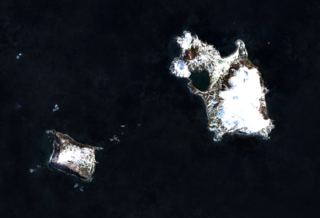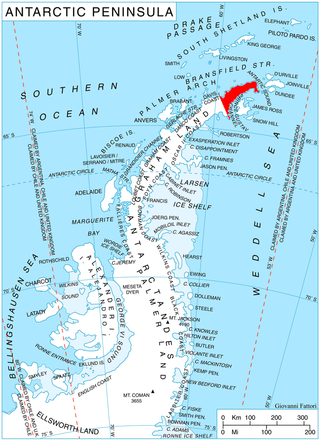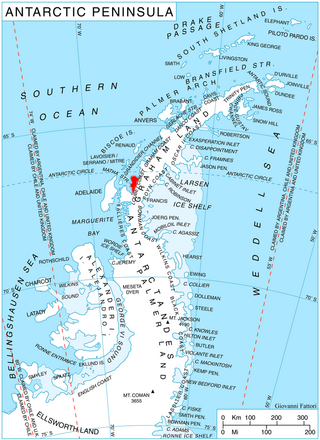Related Research Articles

The Arctic Archipelago, also known as the Canadian Arctic Archipelago, is an archipelago lying to the north of the Canadian continental mainland, excluding Greenland and Iceland.

James Ross Island is a large island off the southeast side and near the northeastern extremity of the Antarctic Peninsula, from which it is separated by Prince Gustav Channel. Rising to 1,630 metres (5,350 ft), it is irregularly shaped and extends 64 km in a north–south direction. It was charted in October 1903 by the Swedish Antarctic Expedition under Otto Nordenskiöld, who named it for Sir James Clark Ross, the leader of a British expedition to this area in 1842 that discovered and roughly charted a number of points along the eastern side of the island. The style, "James" Ross Island is used to avoid confusion with the more widely known Ross Island in McMurdo Sound.

Alejandro Selkirk Island, previously known as Más Afuera and renamed after the marooned sailor Alexander Selkirk, is the largest and most westerly island in the Juan Fernández Archipelago of the Valparaíso Region of Chile. It is situated 180 km west of Robinson Crusoe Island in the southeastern Pacific Ocean.
Breakbones Plateau is a small lava plateau just north of Chimaera Flats on Candlemas Island, South Sandwich Islands. The feature is an interesting biological area containing numerous small fumaroles with attendant vegetation. The name applied by the United Kingdom Antarctic Place-Names Committee in 1971 refers both to the difficulty of travel and to the presence of a large breeding colony of giant petrels, sometimes known as "breakbones".
Buddha Rock is a rock, 35 metres (115 ft) high, lying 0.3 nautical miles (0.6 km) west of Vindication Island in the South Sandwich Islands. It was charted and named in 1930 by Discovery Investigations personnel on the RSS Discovery II.
Chimaera Flats is a broad stretch of flat sand with a smooth surface only a few metres above sea level, between Medusa Pool and Gorgon Pool on Candlemas Island, South Sandwich Islands. The name applied by the UK Antarctic Place-Names Committee in 1971 refers to the chimaera, a mythical fire-eating monster.
Cook Rock is an arched rock, 45 metres (150 ft) high, lying close east of Trousers Rock and 0.3 nautical miles (0.6 km) northeast of Vindication Island in the South Sandwich Islands. It was charted in 1930 by Discovery Investigations personnel on the Discovery II and named for Captain James Cook.

Nelson Channel is a navigable channel between Candlemas and Vindication Islands in Candlemas Islands group, in the South Sandwich Islands. First roughly charted by Captain James Cook, discoverer of these islands in 1775. Recharted in 1930 by DI personnel on the Discovery II, who gave the name "Nelson Strait" for Lieutenant Andrew Laidlaw Nelson, Royal Navy Reserve, chief officer and navigator of the ship. The name has been amended to avoid duplication with Nelson Strait in the South Shetland Islands.
Crosscut Point is a series of jagged rocks forming the north end of Vindication Island in the South Sandwich Islands. It was charted in 1930 by Discovery Investigations personnel on the Discovery II, and so named because numerous crosscutting dikes have withstood weathering and produced this irregular formation.
Trousers Rock is a rock with a prominent wave-cut arch, lying immediately west of Cook Rock and 0.3 nautical miles (0.6 km) northeast of Vindication Island in the South Sandwich Islands. Charted in 1930 and given this descriptive name by DI personnel on the Discovery II.
Mount Perseus is the lower and more northerly of twin ice domes in the east part of Candlemas Island, South Sandwich Islands. Named by United Kingdom Antarctic Place-Names Committee (UK-APC) in 1971 in association with nearby Mount Andromeda. In Greek mythology, Perseus married Andromeda after rescuing her from a sea monster.

Pettus Glacier is a narrow deeply entrenched glacier 9 nautical miles (17 km) long, which flows north from Ebony Wall into Gavin Ice Piedmont between Poynter Hill and Tinsel Dome, Trinity Peninsula. Named by United Kingdom Antarctic Place-Names Committee (UK-APC) for Robert N. Pettus, aircraft pilot with Falkland Islands and Dependencies Aerial Survey Expedition (FIDASE), 1956–57.
Gorgon Pool is a lake, or perhaps lagoon, between the Chimaera Flats and Kraken Cove in Candlemas Island, South Sandwich Islands. It was named by the UK Antarctic Place-Names Committee in association with nearby Medusa Pool. The Gorgon is a mythical creature of Homer's Iliad, linked in other mythology with Medusa.
Lucifer Hill is a reddish, cindery, sulphur-streaked hill forming the summit of the northern section of Candlemas Island in the South Sandwich Islands. It was one of the most active volcanic vents in this island chain at the time of HMS Protector's survey in 1964. The name applied by the UK Antarctic Place-Names Committee after Lucifer refers to the diabolical and infernal mythical association of active volcanoes. Clinker Gulch extends from Lucifer Hill to the northern shore of Candlemas.
Medusa Pool is a tidal lagoon that occupies the west side of the central lowlands of Candlemas Island in the South Sandwich Islands. The name, given by the UK Antarctic Place-Names Committee in 1971, is associated in classical mythology with the geomorphologically similar Gorgon Pool, nearby, Medusa being one of the gorgons.
Mount Machatschek is a prominent, mainly snow-covered mountain in northern Adelaide Island, Antarctica, about 14 nautical miles (26 km) southwest of Mount Velain. It was mapped from air photos taken by the Ronne Antarctic Research Expedition (1947–48) and the Falkland Islands and Dependencies Aerial Survey Expedition (1956–57), and was named by the UK Antarctic Place-Names Committee after Austrian geomorphologist Fritz Machatschek (1876–1957), who was the joint author with Erich von Drygalski of Gletscherkunde, 1942.
Sarcophagus Point is a point at the southeast side of Sea Serpent Cove on the west coast of Candlemas Island, South Sandwich Islands. The point, with a spine of lava cliffs, almost cuts off Medusa Pool from the sea. It was referred to as "The Sarcophagus" on a sketch-survey of Sea Serpent Cove made by a boat party from RRS Discovery II in 1930.

Sölch Glacier is a glacier on the Pernik Peninsula of the Loubet Coast in Graham Land, flowing west to Salmon Cove just north of Kanchov Peak on the east side of Lallemand Fjord. It was mapped from air photos taken by the Falkland Islands and Dependencies Aerial Survey Expedition, 1956–57, and named by United Kingdom Antarctic Place-Names Committee for Johann Sölch (1883–1951), an Austrian glacial geologist and glaciologist.
References
 This article incorporates public domain material from "Cauldron Pool". Geographic Names Information System . United States Geological Survey.
This article incorporates public domain material from "Cauldron Pool". Geographic Names Information System . United States Geological Survey.